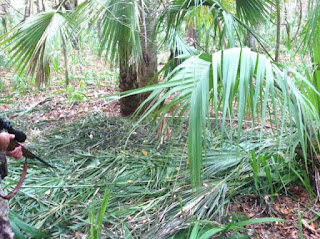 |
| Public Land Hog Taken at Citrus WMA |
Hogs basically have three things on their minds:
1. Feeding
2. Staying cool
3. Breeding
We all know that hogs eat like, well... pigs. I raised a couple little wild hogs and I was amazed by how much they really ate. They would let the whole neighborhood know when they were hungry with their squealing and grunting. When I would bring them their mush they would go crazy over it like they hadn't eaten in years. Hogs eat and they eat a lot!
When my hogs weren't eating, they were trying to stay cool by bedding up under hay or laying in muddy wallows.
I ate them before they reached breeding age so I never did see how that effected their behavior, but I do know that mature hogs breed year around whenever they have the opportunity. Since it's an ongoing thing we're not going to target the hog rut like we do deer.
The secret to a higher success rate is between the bedding area and the feeding area. For starters we need to learn to read their sign. The most common hog sign is rooting because it looks like a land clearing crew went through the property. In my early days of hunting hogs I would set up over a heavily rooted area but never had any success. The reason is that most rooting takes place at night and can be a long way from where the hogs are actually bedding. Also, when hogs root up an area they tend to move to new ground rather than looking for food where they have already rooted. Rooting areas are not a great place to hang a stand but they are a great place to start scouting.
Once I find a rooting area, I look for trails leading to it. Hog trails are well defined and are often marked by dried mud caked on the grass and leaves. Once I find a trail, I start following it. When I do this I usually find myself on a little hog highway with side trails and intersections going in different directions. When I find the most well defined trail that leads to water, I've found the highway to hog heaven.
Hogs don't sweat and they run a high body temperature, so they look for wet areas to stay cool during the day. As long as it's somewhat warm out, which is most of the year in Florida, hogs are going to be bedded in a wet area. For some WMA's this doesn't help narrow down a spot much because the entire property is under water. But for the WMA's that are relatively dry, find the pond or the marsh and the hogs will be concentrated there.
I look for wallows, muddy rubs on trees and droppings. Also I will follow my nose. I've been able to smell the stench of a musky boar bedded up from 50 yards away. These are a sure sign that I'm near their bedroom. Typically, hogs are much more active at night, so if I can find a spot right outside of their bedroom I will have a much better chance of catching one during legal shooting hours. Once I'm confident I'm close, I try to control my curiosity from tromping into their beds and spooking them, which will often cause them to find a new bedding area. I will set up my stand on a main trail leading out of their bedding area. With such a spot I've just upped my odds of catching a hog coming back from feeding in the morning or leaving for the evening.
 |
| Winter Hog Bed In The Palmettos |
While facing a big boar on the ground is definitely a little more unnerving than being safe in a treestand, there are many benefits to hunting hogs from the ground. First is the benefit of maneuverability. If the hogs don't come right to me, they are much easier to put a stalk on than deer. Also if I am archery hunting a big boar I have a better shot angle from the ground than I do from a treestand. I have shot several big boar from a treestand that were protected by their thick armor plate that covers the upper part of their shoulders. I'm shooting a 70 lb. bow and I have shot boar at 15 yards behind the shoulder and they run off with my arrow sticking a few inches in. They don't bleed at all on the outside and I never find them. From the ground there is the benefit of being able to take a low heart shot right behind their armpit. This is the only bow shot that will make for consistently recovering big boar.
One thing about hogs, especially boar, is that they are a lot tougher than a deer and a lot meaner. Even a good shot on a big boar is no guarantee that he will be dead in 20 minutes. Give him plenty of time and be very careful tracking. I've had some really close calls tracking big boar that weren't even close to being dead. They will let you get within inches before they jump up and charge! I've learned that the hands and knees blood trailing method through palmettos at night is a really, really stupid idea! Be ready to shoot, run, or climb a tree; maybe all three in order! Happy hog hunting.






